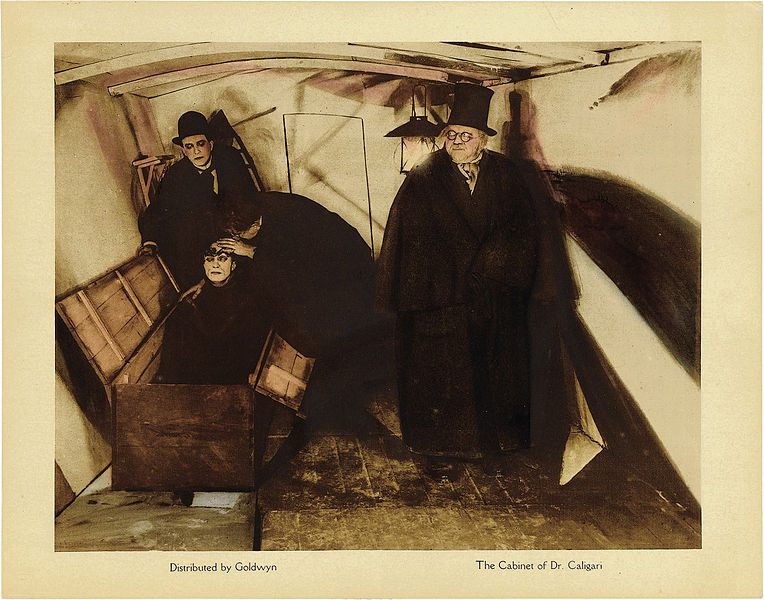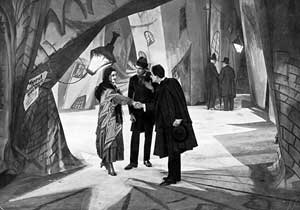The Mad Doctor Meets the Somnambulist
Mitä tapahtuu, on ensimmäinen kaupallisesti menestynyt taide-elokuvan. Kaappi tohtori. Caligari (1920) julkaistiin tammikuussa 1920 tulossa Saksan ja kansainvälinen sensaatio. Se merkitsi saksalaisen elokuvan elpymisen alkua 1920-luvulla
The German Expressionist Movement in German art strongly influenced this film. Ekspressionistiset maalarit piirsivät rakennuksia, jotka ovat kaltevia eri kulmiin, oddly shaped furniture, jne..
The film’s set design reflected this style of composition. Buildings, doors and streets all slope at odd angles or are irregular shapes. Furniture is also oddly shaped. Chairs seats are six feet in the air, bookcases lean and chairs have irregular backs.
Robert Weine filmed in a standard continuity format making the story understandable to the average viewer. The story itself is a horror and detective story told from one man’s perspective, a story within a story.
A mysterious stranger named Dr. Caligari, näytteli Werner Krauss, tulee Hollstenwalliin esittelemään somnambulisti Cesarea, portrayed by Conrad Veidt. A somnambulist sleeps for days on end. Calagari sanoo, että Cesare on nukkunut 20 to 30 vuotta. Coincidentally or not, a series of murders occur once Caligari and Cesare arrive in Hollstenwall.
The protagonist of the film is Francis (Friedrich Feher), who is in love with Jane (Lil Dagover). Tuntematon paholainen murhaa Francisin’ ystävä, joka johdatti Francisin tavoittelemaan Dr. Caligari, kenen Franciscus uskoo olevan vastuussa murhasta.
Jatkuva jännite Francisin ja Caligarin välillä ohjaa tarinaa, which is complicated by Cesare’s infatuation with Jane, Francis’ love interest.
Weine kuvasi twist-lopun, jota en spoilaa puolestasi. Hans Janowitz ja Carl Mayer kirjoittivat elokuvan ja vastustivat voimakkaasti Weinen muutoksia. Weine ei uskonut, että yleisö hyväksyisi elokuvan ilman kierteen loppua.
You will want to view this movie on the Special Collector’s Edition DVD, which restored the film to its original speed of 18 jalkaa sekunnissa. American films were shot at 24 jalkaa sekunnissa. When the original copies for video distribution were made, a copy of the film was recorded on a 24 feet per second projector. The recording at a different speed made the film look a bit quirky and rushed. The film actually has a very deliberate pace, when viewed at the proper projection speed.
The Expressionist scenery will distract you at first. When I first watched the film about ten years ago for a college class, my wife and kids thought I was watching some 1960s psychedelic drug film. Even after explaining Expressionism, they thought it was odd. All three of my children have watched the film to mixed reviews. I will let you decide on the film yourself.
Päivitys: I recently saw the restored version on Netflix. I recommend this copy also.
You can leave a comment or ask a question about this or any post on my Facebook page ja Twitter profile.
Pin It


